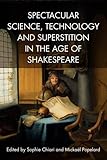Spectacular Science, Technology and Superstition in the Age of Shakespeare / Sophie Chiari, Mickaël Popelard.
Material type: TextPublisher: Edinburgh : Edinburgh University Press, [2022]Copyright date: ©2017Description: 1 online resource (288 p.) : 1 B/W illustrationsContent type:
TextPublisher: Edinburgh : Edinburgh University Press, [2022]Copyright date: ©2017Description: 1 online resource (288 p.) : 1 B/W illustrationsContent type: - 9781474427814
- 9781474427838
- 822.33 23
- PR3047 .S64 2017
- PR3047 .S64 2017
- online - DeGruyter
| Item type | Current library | Call number | URL | Status | Notes | Barcode | |
|---|---|---|---|---|---|---|---|
 eBook
eBook
|
Biblioteca "Angelicum" Pont. Univ. S.Tommaso d'Aquino Nuvola online | online - DeGruyter (Browse shelf(Opens below)) | Online access | Not for loan (Accesso limitato) | Accesso per gli utenti autorizzati / Access for authorized users | (dgr)9781474427838 |
Frontmatter -- Contents -- Acknowledgements -- Textual Note -- Notes on Contributors -- Introduction -- Part I. Popular Beliefs -- 1. The ‘Science’ of Astrology in Shakespeare’s Sonnets, Romeo and Juliet and King Lear -- 2. Staging Devils and Witches: Had Shakespeare Read Reginald Scot’s The Discoverie of Witchcraft? -- Part II. Healing and Improving -- 3. ‘Remedies for Life’: Curing Hysterica Passio in Shakespeare’s Othello, Macbeth and The Winter’s Tale -- 4. ‘More, I prithee, more’: Melancholy, Musical Appetite and Medical Discourse in Shakespeare’s Twelfth Night -- 5. Saving Perfection from the Alchemists: Shakespeare’s Use of Alchemy -- Part III. Knowledge and (Re)Discoveries -- 6. Of Mites and Motes: Shakespearean Readings of Epicurean Science -- 7. Shakespeare’s Alhazen: Love’s Labour’s Lost and the History of Optics -- 8. Shakespeare’s Montaigne: Maps and Books in The Tempest -- 9. Unlimited Science: The Endless Transformation of Nature in Bacon and Shakespeare’s The Tempest -- Part IV. Mechanical Tropes -- 10. ‘Vat is the clock, Jack?’: Shakespeare and the Technology of Time -- 11. ‘Wheels have been set in motion’: Geocentrism and Relativity in Tom Stoppard’s Rosencrantz and Guildenstern Are Dead -- Coda: Scepticism and the Spectacular – On Shakespeare in an Age of Science -- Bibliography -- Index
restricted access online access with authorization star
http://purl.org/coar/access_right/c_16ec
Explores the interaction between science, literature and spectacle in Shakespeare’s eraTo the readers who ask themselves: ‘What is science?’, this volume provides an answer from an early modern perspective, whereby science included such various intellectual pursuits as history, poetry, occultism and philosophy. By exploring particular aspects of Shakespearean drama, this collection illustrates how literature and science were inextricably linked in the early modern period. In order to bridge the gap between Renaissance literature and early modern science, the essays collected here focus on a complex intellectual territory situated at the point of juncture between humanism, natural magic and craftsmanship. It is argued that science and literature constantly interacted, thus revealing that what we now call ‘literature’ and what we choose to describe as ‘science’ were not clear-cut categories in Shakespeare’s days but rather a part of common intellectual territory.Key FeaturesAnalyses different aspects of Shakespeare’s plays through the prism of early modern science Sheds fresh light on major works such as the Sonnets, Love’s Labour’s Lost, Romeo and Juliet, Twelfth Night, King Lear, Hamlet, Othello, Macbeth, The Tempest, The Winter’s TaleCombines theoretical views, historical approaches, and close readingsOffers an innovative dialectic vision of the Shakespeare/science nexus, taking up Mazzio’s seminal idea that it is now necessary to move beyond forms of analysis focused largely on thematic traces of, or indeed linguistic reflections of, historically specific arenas of scientific practice" Links science and spectacle and posits that early modern theatre fashioned the reception of early modern discoveriesPays attention to systems of thought which bind together scientific and literary discourses, practices and mentalities within a single episteme (in Michel Foucault’s interpretation of the word)"
Mode of access: Internet via World Wide Web.
In English.
Description based on online resource; title from PDF title page (publisher's Web site, viewed 29. Jun 2022)


